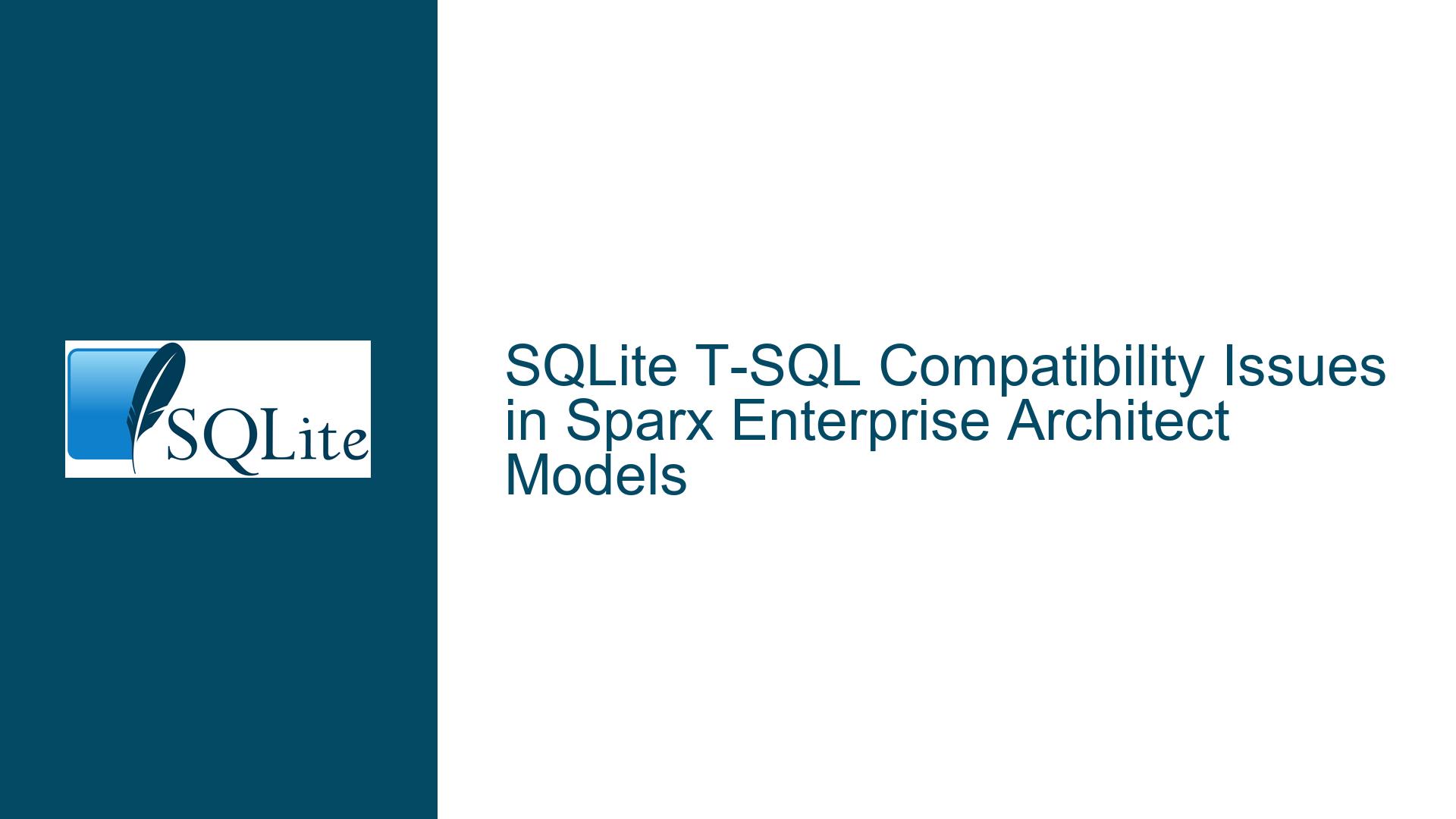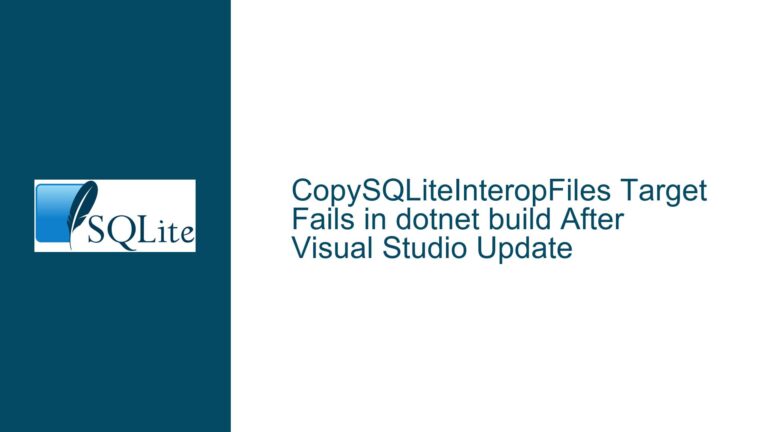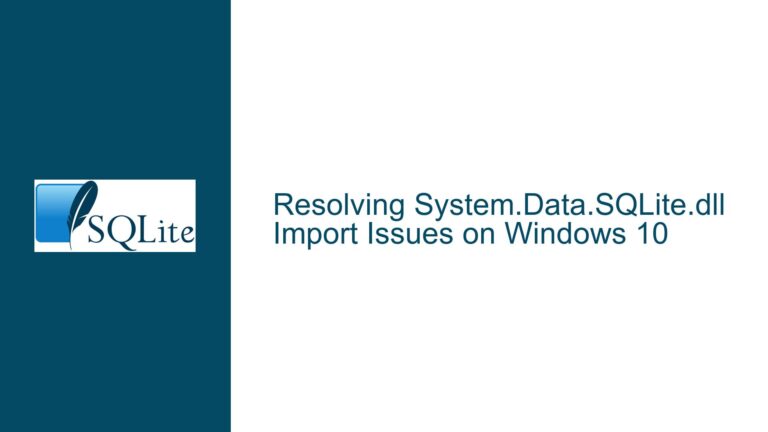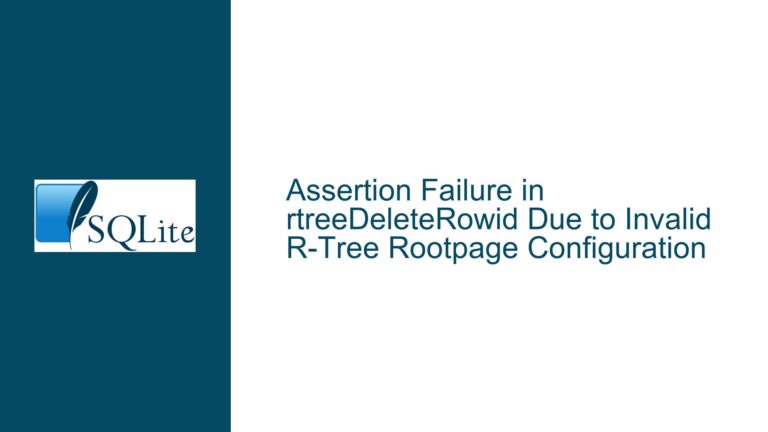SQLite T-SQL Compatibility Issues in Sparx Enterprise Architect Models
SQLite’s Lack of T-SQL Extensions and Its Impact on Sparx Enterprise Architect Models
Issue Overview
The core issue revolves around the incompatibility of T-SQL extensions in SQLite, particularly when used within Sparx Enterprise Architect models. Sparx Enterprise Architect is a modeling tool that abstracts the data layer, allowing users to create SQL queries directly on the data layer of the model. These models can be stored in different database backends, including SQLite for file-based models and PostgreSQL or SQL Server for centralized models. The problem arises when SQL queries written for PostgreSQL or SQL Server, which support T-SQL extensions like concat, concat_ws, string_agg, and substring, are not compatible with SQLite. This incompatibility creates a significant hurdle when trying to distribute file-based models (using SQLite) while maintaining the same SQL queries for centralized models (using PostgreSQL or SQL Server).
SQLite, being a lightweight database, does not natively support many T-SQL extensions. For instance, SQLite uses the || operator for string concatenation instead of the concat function, and it provides substr instead of substring. While SQLite does offer group_concat as an alternative to string_agg, it lacks the ability to use order by within the aggregate function, which is a feature available in PostgreSQL and SQL Server. This discrepancy in SQL syntax and functionality between SQLite and other databases like PostgreSQL or SQL Server creates a barrier to achieving query interchangeability across different database backends within Sparx Enterprise Architect.
The issue is further compounded by the fact that Sparx Enterprise Architect abstracts the data layer, meaning that the same SQL queries are expected to work seamlessly across different database backends. However, due to the differences in SQL syntax and functionality, queries that work perfectly in PostgreSQL or SQL Server may fail or produce incorrect results in SQLite. This limitation not only affects the portability of the models but also increases the complexity of maintaining and distributing these models, especially when the target environment uses SQLite as the backend.
Possible Causes
The root cause of this issue lies in the fundamental differences between SQLite and other databases like PostgreSQL and SQL Server in terms of SQL syntax and functionality. SQLite is designed to be lightweight and minimalistic, which means it does not support many of the advanced SQL features and extensions that are available in more robust databases like PostgreSQL and SQL Server. This design philosophy makes SQLite an excellent choice for embedded systems and lightweight applications but creates challenges when trying to use it in environments where compatibility with other databases is required.
One of the primary causes of the incompatibility is the lack of support for T-SQL extensions in SQLite. T-SQL, which is an extension of SQL used by SQL Server, includes a variety of functions and features that are not available in standard SQL. For example, the concat function, which is commonly used in T-SQL for string concatenation, is not supported in SQLite. Instead, SQLite uses the || operator for string concatenation, which, while functionally equivalent, can be less readable and more cumbersome to use, especially when concatenating multiple strings.
Another cause of the issue is the difference in aggregate functions between SQLite and other databases. While SQLite provides group_concat as an alternative to string_agg, it does not support the order by clause within the aggregate function, which is a feature available in PostgreSQL and SQL Server. This limitation can lead to inconsistencies in the results produced by the same query when run on different databases, making it difficult to achieve query interchangeability.
The abstraction layer provided by Sparx Enterprise Architect also contributes to the problem. While abstraction layers are designed to simplify the process of working with different databases by providing a unified interface, they can also obscure the underlying differences between databases. In the case of Sparx Enterprise Architect, the abstraction layer does not account for the differences in SQL syntax and functionality between SQLite and other databases, leading to queries that work in one environment but fail in another.
Finally, the issue is exacerbated by the fact that SQLite is often used in file-based models, which are intended to be distributed to other users. When these models contain SQL queries that are not compatible with SQLite, it becomes impossible to distribute the models without modifying the queries. This limitation not only affects the portability of the models but also increases the complexity of maintaining and distributing them, especially when the target environment uses SQLite as the backend.
Troubleshooting Steps, Solutions & Fixes
To address the issue of SQLite’s lack of T-SQL compatibility in Sparx Enterprise Architect models, several steps can be taken to ensure that SQL queries are compatible across different database backends. These steps include modifying the SQL queries to be compatible with SQLite, using alternative functions and syntax, and leveraging the capabilities of Sparx Enterprise Architect to handle database-specific queries.
The first step in troubleshooting this issue is to identify the specific T-SQL extensions and functions that are not supported by SQLite. This includes functions like concat, concat_ws, string_agg, and substring. Once these functions have been identified, the next step is to find equivalent functions or syntax in SQLite that can be used to achieve the same result. For example, the concat function can be replaced with the || operator in SQLite, and the substring function can be replaced with substr.
In cases where SQLite does not provide a direct equivalent for a T-SQL function, alternative approaches may need to be used. For example, while SQLite does not support the order by clause within the group_concat function, it is possible to achieve a similar result by using a subquery to order the data before applying the group_concat function. This approach may require more complex SQL queries, but it can help to achieve the desired result while maintaining compatibility with SQLite.
Another approach to resolving this issue is to use conditional SQL queries that are specific to the database backend. Sparx Enterprise Architect allows users to define database-specific queries, which can be used to handle differences in SQL syntax and functionality between databases. By defining separate queries for SQLite and other databases, it is possible to ensure that the correct query is used for each database backend, thereby avoiding compatibility issues.
In addition to modifying the SQL queries, it may also be necessary to update the Sparx Enterprise Architect model to handle database-specific queries. This can be done by defining separate queries for each database backend and using conditional logic to determine which query to use based on the database being used. This approach requires a deeper understanding of the Sparx Enterprise Architect model and may involve modifying the model’s configuration files or scripts.
Finally, it is important to consider the long-term implications of using SQLite as a backend for Sparx Enterprise Architect models. While SQLite is a powerful and lightweight database, its lack of support for T-SQL extensions and advanced SQL features may limit its suitability for certain use cases. In cases where compatibility with other databases is a critical requirement, it may be necessary to consider alternative database backends that provide better support for T-SQL extensions and advanced SQL features.
In conclusion, the issue of SQLite’s lack of T-SQL compatibility in Sparx Enterprise Architect models can be addressed through a combination of modifying SQL queries, using alternative functions and syntax, and leveraging the capabilities of Sparx Enterprise Architect to handle database-specific queries. By taking these steps, it is possible to ensure that SQL queries are compatible across different database backends, thereby maintaining the portability and maintainability of Sparx Enterprise Architect models.






